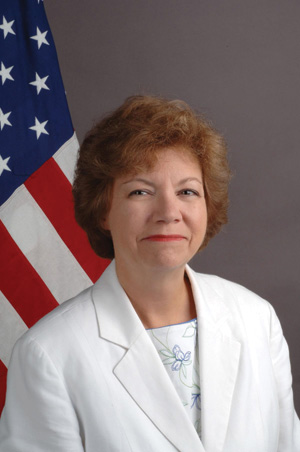RAPAPORT...

|
Gillian Milovanovic
|
Can say that it was a very positive meeting where a lot of
work was accomplished,” said Gillian Milovanovic, who is representing the U.S.
as the current chair of the Kimberley Process (KP). She was referring to the KP
intercessional meeting held in Washington D.C. in early June. “The
intercessional, as you know, is not a time for making decisions, for presenting
proposals and having decisions made,” continued Milovanovic. “It is an
opportunity for discussion, an opportunity for an exchange of ideas, as well as
an opportunity to hear from outside organizations and for our members to see
how to work with these organizations. Although the intercessional has
concluded, the work isn’t over.”
While many issues, including artisanal mining and the KP’s
enforcement and implementation strategies, were discussed, the most hotly
debated item on the agenda was whether to expand the organization’s definition
of “conflict diamonds” to include human rights abuses. Milovanovic indicated
that the question, which has met with some resistance from Asian and African
countries, was not based solely on a Western agenda, but was part of a broader
review of the KP agreed to by its members in 2011.
“The Kimberley Process, itself, mandated the creation of a
review committee and gave it a list of things to examine and to report on, and
to advance; and listed among those are the core definitions of the Kimberley
Process,” Milovanic explained. “The issue of examining the matter, debating the
matter, exploring different avenues and possibilities — that is not subject to
discussion as to whether it can happen, as the whole organization has already
made that decision.’’
SYSTEMATIC VIOLENCE
Addressing the concerns of Asian and African countries, the
chair advised that the new definition would focus solely on mining-related
violence and would not seek to reprimand countries for violence that fell
outside the scope of the diamond industry. “Essentially, we are talking about
systematic things, not one-off situations or something that is unrelated to the
diamond world,” Milovanovic said.
While nothing was finalized at the intercessional meeting,
Milovanovic confirmed that the groundwork is now in place for future discussion
by KP members on redefining conflict diamonds.
A statement by the U.S. State Department noted that
“currently, the term ‘conflict’ that provides the foundation for the Kimberley
Process mandate — namely, situations involving rebel movements seeking to overthrow
legitimate governments — specifically reflects concerns in the years leading up
to the KP founding in 2003. It must now be updated to reflect the challenges of
today and tomorrow. To achieve this, we proposed that the definition of
‘conflict diamond’ used within the KP’s certification scheme should be modified
to cover ‘rough diamonds used to finance, or otherwise directly related to,
armed conflict or other situations of violence.’”
OPEN TIMETABLE
Coming off the heels of a contentious KP plenary meeting in
November 2011, where Zimbabwe was given permission to sell rough diamonds from
the Marange region, much to the chagrin of various nongovernmental
organizations (NGOs) that had been monitoring the situation in Zimbabwe, many
members attending this recent intercessional meeting commended Milovanovic for
creating a welcoming and supportive environment.
While there was praise for the open and frank discussions
held at the meeting, there was no movement to put a strict timetable on when
the definition of “conflict diamonds” would be updated.
“Let us not overstep the mark and say that all gaps in the
Kimberley Process have been bridged in one meeting. From experience we know
that this is not the way things work in the KP,” advised Eli Izhakoff, chairman
of the World Diamond Council (WDC). “Change comes about gradually, and always
as the result of an ongoing dialogue and a general desire to see outstanding
issues resolved. That is the way things worked in the past, and it is the way
that I expect things to develop in this specific instance.”
“I am reluctant to make predictions,” continued Izhakoff,
“other than one that says, ‘Ultimately, we will resolve the issue.’ How long it
takes, and whether it will be before the next plenary session in November, is not
known at present.”
SALUTE TO BOTSWANA
More than 150 diamond and jewelry industry leaders,
diplomats, government officials and delegates to the Kimberley Process (KP)
attended the “Gala Salute to Botswana: Diamonds Empower Africa” on June 5 at
the Embassy of Botswana, in Washington, D.C. The lead sponsor for the event was Tiffany & Co.

|
Gaborone, Botswana
|
Phyllis Bergman, president of the Diamond Empowerment Fund
(DEF), a co-host of the event, said, “Our industry supports the empowerment of
Africa. We are pleased to pay tribute and to salute the outstanding progress
that Botswana continues to achieve, and that represents the good that diamonds
do to improve the quality of life of people and communities in Africa.” DEF
supports education initiatives in diamond-producing nations, including
Botswana.
A student in an education program supported by Botswana and
the DEP told the gathering that “You have given me the opportunity to change my
life and to enhance the future of Botswana. I will not let you down.”
Tebelelo Mazile Seretse, Botswana ambassador to the U.S.,
said the evening was “Botswana’s time to shine as a model for what is possible
when good governance is combined with good corporate social responsibility and
best business practices from the private sector and government.”
The gala was held while KP members were in town for the
organization’s intercessional meeting.
Article from the Rapaport Magazine - July 2012. To subscribe click here.